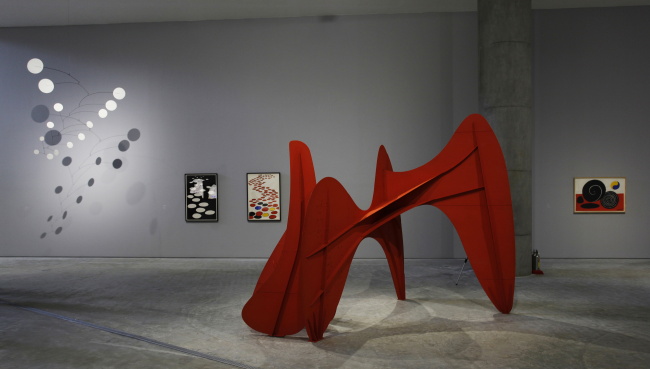Sculpture set free
First major retrospective of Alexander Calder is being held at Leeum, Samsung Museum of Art
By Lee Woo-youngPublished : July 21, 2013 - 19:11
Alexander Calder had always liked toys and games, according to an unpublished autobiographical manuscript from 1955-56.
In fact, he was briefly involved in designing children’s toys for commercial production. And he enjoyed playing billiards ― a game that involves vectors and velocities, engineering concepts that Calder kept in mind in developing his art.
The American artist is hailed for liberating sculptures from the pedestal and constantly proposing new visions of art beyond conventional forms.
Calder’s quest to reset the boundaries of traditional sculpture can be seen at a glance at the first major retrospective of the artist in Seoul at Leeum, Samsung Museum of Art until Oct. 20.
In fact, he was briefly involved in designing children’s toys for commercial production. And he enjoyed playing billiards ― a game that involves vectors and velocities, engineering concepts that Calder kept in mind in developing his art.
The American artist is hailed for liberating sculptures from the pedestal and constantly proposing new visions of art beyond conventional forms.
Calder’s quest to reset the boundaries of traditional sculpture can be seen at a glance at the first major retrospective of the artist in Seoul at Leeum, Samsung Museum of Art until Oct. 20.

The exhibition showcases 118 items, including Calder’s signature mobiles, stabiles, paintings and jewelry pieces on loan from the Calder Foundation.
Some of the highlights of the exhibition include 1971’s “Grand Crinkly,” installed in the museum’s outdoor garden, which is considered one of the artist’s most innovative works, with the angular, geometric figures of the upper section mobile and the lower part crinkled and static.
With his background in mechanical engineering and art, Calder focused on engineering concepts like volume, vector, and density in the making of his works. Yet, he stated in an interview done in 1962 that the source of his art was not machines, but nature.
“I haven’t really touched machinery except for a few elementary mechanisms like levers and balances. You see nature and then you try to emulate it. But, of course, when I met Mondrian I went home and tried to paint. The basis of everything for me is the universe.
“The simplest forms in the universe are the sphere and the circle. I represent them by discs and then I vary them. My whole theory about art is the disparity that exists between form, masses and movement,” said Calder in the 1962 interview.
An account of how the artist’s best-known form, “mobile,” was created is important in understanding the exhibition.

In 1930, Calder, then 32, visited the studio of Piet Mondrian. Instantly amazed by the world of abstract painting, Calder spent two weeks painting abstract art, including 1930’s “Untitled,” featuring some of the basic components of his mobile forms such as colored circles, linear shapes and lines.
Calder returned to making sculptures, incorporating the elements he saw in abstract paintings to eventually create moving sculptures.
The works of the exhibition date back to early 1920 when Calder started taking classes at the Art Students League after graduating from college in mechanical engineering. The Black Box exhibition hall at Leeum features his earlier works created during his art student days, including paintings, animal sketches and wire sculptures, and works from his early phase of mobile construction.
The Ground Gallery features works from the 1940s and monumental sculptures for public spaces that he created in his later years.
The exhibition continues through Oct. 20 at Leeum, Samsung Art Museum. The museum is closed on Monday and opens from 10:30 a.m. to 6 p.m. Admission is 8,000 won for adults and 5,000 won for students. English-language docent-guided tours are available on Saturday and Sunday at 2 p.m.
For more information, call (02) 2014-6901.
By Lee Woo-young (wylee@heraldcorp.com)


















